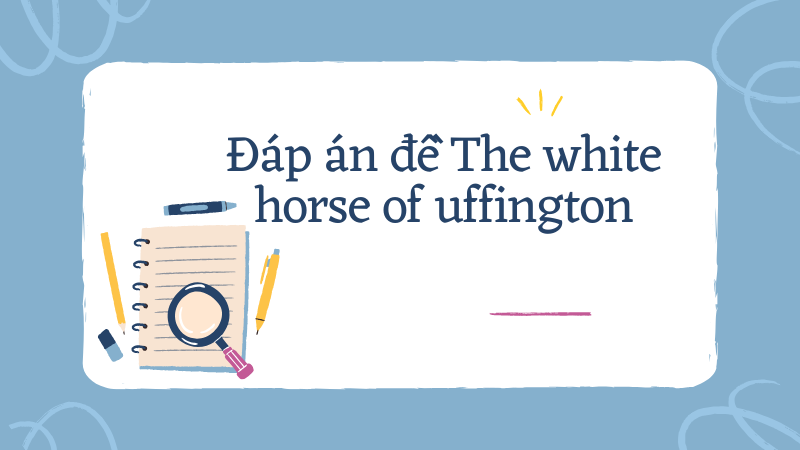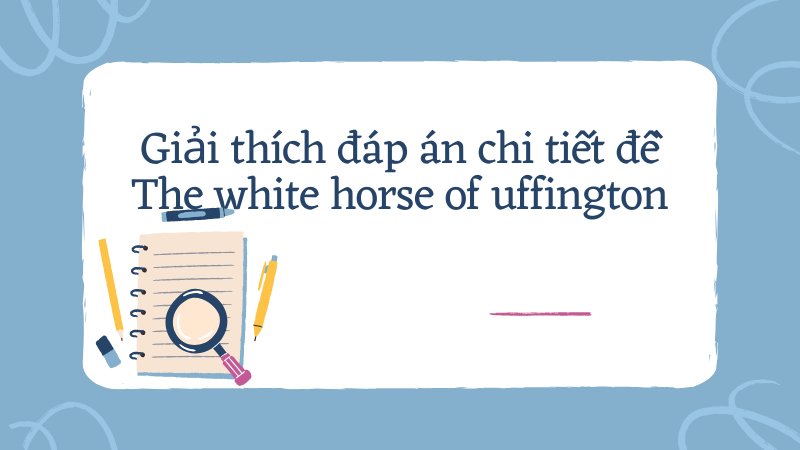The white horse of uffington là bài đọc xuất hiện trong Đề Cam 16, Test 2, Reading Passage 1, tại bài viết dưới đây, hãy cùng Edmicro xem qua đáp án cũng như giải thích đáp án cho từng câu:
Đề bài
The White Horse of Uffington
The cutting of huge figures or ‘geoglyphs’ into the earth of English hillsides has taken place for more than 3,000 years. There are 56 hill figures scattered around England, with the vast majority on the chalk downlands of the country’s southern counties. The figures include giants, horses, crosses and regimental badges. Although the majority of these geoglyphs date within the last 300 years or so, there are one or two that are much older.
The most famous of these figures is perhaps also the most mysterious – the Uffington White Horse in Oxfordshire. The White Horse has recently been re-dated and shown to be even older than its previously assigned ancient pre-Roman Iron Age* date. More controversial is the date of the enigmatic Long Man of Wilmington in Sussex. While many historians are convinced the figure is prehistoric, others believe that it was the work of an artistic monk from a nearby priory and was created between the 11th and 15th centuries.
The method of cutting these huge figures was simply to remove the overlying grass to reveal the gleaming white chalk below. However, the grass would soon grow over the geoglyph again unless it was regularly cleaned or scoured by a fairly large team of people. One reason that the vast majority of hill figures have disappeared is that when the traditions associated with the figures faded, people no longer bothered or remembered to clear away the grass to expose the chalk outline. Furthermore, over hundreds of years the outlines would sometimes change due to people not always cutting in exactly the same place, thus creating a different shape to the original geoglyph. The fact that any ancient hill figures survive at all in England today is testament to the strength and continuity of local customs and beliefs which, in one case at least, must stretch back over millennia.
The Uffington White Horse is a unique, stylised representation of a horse consisting of a long, sleek back, thin disjointed legs, a streaming tail, and a bird-like beaked head. The elegant creature almost melts into the landscape. The horse is situated 2.5 km from Uffington village on a steep slope close to the Late Bronze Age* (c. 7th century BCE) hillfort of Uffington Castle and below the Ridgeway, a long-distance Neolithic** track.
The Uffington Horse is also surrounded by Bronze Age burial mounds. It is not far from the Bronze Age cemetery of Lambourn Seven Barrows, which consists of more than 30 well-preserved burial mounds. The carving has been placed in such a way as to make it extremely difficult to see from close quarters, and like many geoglyphs is best appreciated from the air. Nevertheless, there are certain areas of the Vale of the White Horse, the valley containing and named after the enigmatic creature, from which an adequate impression may be gained. Indeed on a clear day the carving can be seen from up to 30 km away.
The earliest evidence of a horse at Uffington is from the 1070s CE when ‘White Horse Hill’ is mentioned in documents from the nearby Abbey of Abingdon, and the first reference to the horse itself is soon after, in 1190 CE. However, the carving is believed to date back much further than that. Due to the similarity of the Uffington White Horse to the stylised depictions of horses on 1st century BCE coins, it had been thought that the creature must also date to that period.
However, in 1995 Optically Stimulated Luminescence (OSL) testing was carried out by the Oxford Archaeological Unit on soil from two of the lower layers of the horse’s body, and from another cut near the base. The result was a date for the horse’s construction somewhere between 1400 and 600 BCE – in other words, it had a Late Bronze Age or Early Iron Age origin.
The latter end of this date range would tie the carving of the horse in with occupation of the nearby Uffington hillfort, indicating that it may represent a tribal emblem marking the land of the inhabitants of the hillfort. Alternatively, the carving may have been carried out during a Bronze or Iron Age ritual. Some researchers see the horse as representing the Celtic*** horse goddess Epona, who was worshipped as a protector of horses, and for her associations with fertility. However, the cult of Epona was not imported from Gaul (France) until around the first century CE. This date is at least six centuries after the Uffington Horse was probably carved. Nevertheless, the horse had great ritual and economic significance during the Bronze and Iron Ages, as attested by its depictions on jewellery and other metal objects. It is possible that the carving represents a goddess in native mythology, such as Rhiannon, described in later Welsh mythology as a beautiful woman dressed in gold and riding a white horse.
The fact that geoglyphs can disappear easily, along with their associated rituals and meaning, indicates that they were never intended to be anything more than temporary gestures. But this does not lessen their importance. These giant carvings are a fascinating glimpse into the minds of their creators and how they viewed the landscape in which they lived.
Questions 1-8
Do the following statements agree with the information given in Reading Passage 1?
In boxes 1-8 on your answer sheet, write
| TRUE | if the statement agrees with the information |
| FALSE | if the statement contradicts the information |
| NOT GIVEN | if there is no information on this |
1 – Most geoglyphs in England are located in a particular area of the country.
2 – There are more geoglyphs in the shape of a horse than any other creature.
3 – A recent dating of the Uffington White Horse indicates that people were mistaken about its age.
4 – Historians have come to an agreement about the origins of the Long Man of Wilmington.
5 – Geoglyphs were created by people placing white chalk on the hillside.
6 – Many geoglyphs in England are no longer visible.
7 – The shape of some geoglyphs has been altered over time.
8 – The fame of the Uffington White Horse is due to its size.
Questions 9-13
Complete the notes below.
Choose ONE WORD ONLY from the passage for each answer.
Write your answers in boxes 9-13 on your answer sheet.
| The Uffington White Horse |
| The location of the Uffington White Horse: – a distance of 2.5 km from Uffington village – near an ancient road known as the 9………………. – close to an ancient cemetery that has a number of burial mounds Dating the Uffington White Horse: – first reference to White Horse Hill appears in 10………… from the 1070s – horses shown on coins from the period 100 BCE – 1 BCE are similar in appearance – according to analysis of the surrounding 11……………., the Horse is Late Bronze Age / Early Iron Age Possible reasons for creation of the Uffington White Horse: – an emblem to indicate land ownership – formed part of an ancient ritual – was a representation of goddess Epona – associated with protection of horses and 12……………….. – was a representation of a Welsh goddess called 13………………….. |
Đáp án đề The white horse of uffington
Các bạn hãy đối chiếu đáp án của mình với đáp án dưới đây nhé!

| Câu hỏi | Đáp án |
|---|---|
| 1 | TRUE |
| 2 | NOT GIVEN |
| 3 | TRUE |
| 4 | FALSE |
| 5 | FALSE |
| 6 | TRUE |
| 7 | TRUE |
| 8 | NOT GIVEN |
| 9 | RIDGEWAY |
| 10 | DOCUMENTS |
| 11 | SOIL |
| 12 | FERTILITY |
| 13 | RHIANNON |
Xem thêm: Intensive IELTS Reading – Review Chi Tiết Và Link Download
Giải thích đáp án chi tiết đề The white horse of uffington
Dưới đây là giải thích chi tiết cho bài đọc The white horse of uffington
Question 1- 8
Question 1
Đáp án True
Đoạn chứa đáp án: Paragraph 1
Giải thích: Trong đoạn 1, có một câu nói “There are 56 hill figures in England, most of which are found in the chalk downlands of the south of the country. Giants, horses, crosses, and regimental insignia are among the figures.” Đoạn văn chỉ rõ rằng các hình tượng địa lý, còn được gọi là hình tượng trên đồi, rất nhiều, phần lớn được tìm thấy ở phía nam đất nước. Thông tin này phù hợp với câu hỏi, khiến câu trả lời đúng là “YES” dựa trên lời giải thích đã cho.
Question 2
Đáp án đúng: Not Given
Giải thích: Các đoạn văn không chứa bất kỳ thông tin liên quan nào về câu hỏi phát biểu “There are more geoglyphs in the shape of a horse than any other creature.” Do đó, câu trả lời đúng là “Not Given.”
Question 3
Đáp án đúng: True
Đoạn chứa đáp án: Paragraph 2
Giải thích: Những dòng này trong đoạn 2: “Re-dating of The White Horse has recently revealed that it is actually far older than the previously assumed pre-Roman Iron Age* age.” Điều này cho thấy mọi người đã có những hiểu lầm về tuổi của nó, và thông qua việc xác định lại niên đại, thông tin chính xác đã được thu thập. Do đó, câu trả lời đúng là “YES” dựa trên lời giải thích đã cho.
Question 4
Đáp án đúng: False
Đoạn chứa đáp án: Paragraph 2
Giải thích: Câu hỏi nêu mâu thuẫn với thông tin trình bày trong đoạn 2. Trong khi câu hỏi ngụ ý sự đồng thuận của các nhà sử học, đoạn 2 chỉ ra các quan điểm khác nhau liên quan đến nguồn gốc của Người đàn ông dài ở Wilmington. Do đó, câu trả lời đúng là “False”.
Question 5
Đáp án đúng: False
Đoạn chứa đáp án: Paragraph 3
Giải thích: Câu hỏi nêu mâu thuẫn với thông tin trình bày trong đoạn 3. Câu hỏi nói rằng mọi người sử dụng phấn trắng trên sườn đồi để tạo ra các hình vẽ địa hình, nhưng quá trình thực tế là cắt cỏ để lộ ra phấn trắng lấp lánh bên dưới. Vì vậy, câu trả lời đúng là “False.”
Xem thêm: Improve Your IELTS Reading Skills: Review & Hướng Dẫn Mới Nhất
Question 6
Đáp án đúng: True
Đoạn chứa đáp án: Paragraph 3
Giải thích: Trong đoạn 3, tác giả thảo luận về sự biến mất của các hình tượng trên đồi. Các dòng giải thích rằng khi phong tục thay đổi, mọi người ngừng loại bỏ lớp cỏ phía trên để lộ lớp phấn trắng bên dưới. Điều này khiến các hình tượng trên đồi biến mất. Do đó, dựa trên lời giải thích được cung cấp, câu trả lời đúng là “True.”
Question 7
Đáp án đúng: True
Đoạn chứa đáp án: Paragraph 3
Giải thích:Trong đoạn 3, rõ ràng là hình dạng của các hình vẽ địa hình đã thay đổi theo thời gian. Mọi người đã bỏ qua việc loại bỏ lớp cỏ đúng cách hoặc cắt nó một cách chính xác, dẫn đến sự thay đổi hình dạng của các hình vẽ địa hình. Do đó, dựa trên lời giải thích được đưa ra, câu trả lời đúng là “True.”
Question 8
Đáp án đúng: Not Given
Giải thích: Các đoạn văn không chứa bất kỳ thông tin liên quan nào về câu hỏi “The fame of the Uffington White Horse is due to its size.”. Do đó, câu trả lời là. “Not given.”

Question 9 – 13
Question 9
Đáp án đúng: Ridgeway
Đoạn chứa đáp án: Paragraph 4
Giải thích: Đoạn 4 cung cấp thông tin rõ ràng về vị trí của White Horse of Uffington. Nó nằm cách làng Uffington khoảng 2,5 km, dọc theo một con đường được gọi là Ridgeway. Do đó, câu trả lời đúng, như đã giải thích, là “Ridgeway”.
Question 10
Đáp án đúng: Documents
Đoạn chứa đáp án: Paragraph 6
Giải thích: Sự xuất hiện đầu tiên của đồi White Horse của Uffington được đề cập rõ ràng trong đoạn 6, nơi nó được tìm thấy trong các tài liệu lịch sử. Do đó, dựa trên lời giải thích được cung cấp, câu trả lời đúng là “documents.”
Question 11
Đáp án đúng: Soil
Đoạn chứa đáp án: Paragraph 7
Giải thích: Như đã đề cập trong đoạn 8, con ngựa có niên đại từ cuối thời kỳ đồ đồng hoặc đầu thời kỳ đồ sắt. Xác định này được đưa ra bằng cách kiểm tra đất xung quanh do đơn vị Khảo cổ học thực hiện. Do đó, câu trả lời đúng, như đã giải thích, là “Soil.”
Question 12
Đáp án đúng: Fertility
Đoạn chứa đáp án: Paragraph 8
Giải thích: Đoạn 8 đề cập đến nữ thần ngựa Celtic, Epona, và nhấn mạnh rằng con ngựa tượng trưng cho việc thờ phụng các vị thần. Epona cũng liên quan đến khả năng sinh sản. Do đó, câu trả lời đúng, như đã giải thích, là “fertility.”
Question 13
Đáp án đúng: Rhiannon
Đoạn chứa đáp án: Paragraph 8
Giải thích: Đoạn 8 đề cập đến hình ảnh một vị thần và một nữ thần xứ Wales. Nữ thần xứ Wales Rhiannon được miêu tả là một người phụ nữ xinh đẹp cưỡi một con ngựa trắng và được trang điểm bằng vàng. Do đó, câu trả lời đúng, như đã giải thích, là “Rhiannon”.
Trên đây là bài mẫu gợi ý cho đề The white horse of uffington – Đề Cam 16, Test 2, Reading Passage 1 được đội ngũ chuyên môn tại Edmicro biên soạn. Hy vọng bài viết trên sẽ giúp ích cho các bạn trong quá trình Edmicro IELTS tại nhà.
Xem thêm:











